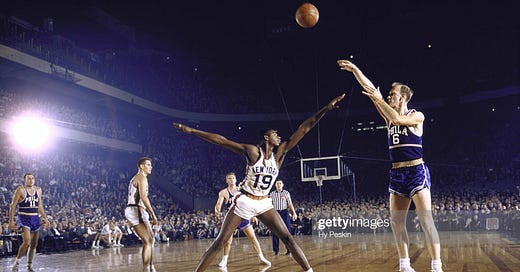Well, with George Mikan retired, we have our first Lost MVP race without his bespectacled specter looming over the award. Furthermore, this is the first season of the shot clock and the final time an NBA franchise folded (RIP, original Baltimore Bullets). The times indeed were a-changin’ in the NBA!
But will the Lost MVP award change hands to a new champion?
Can 1954 winner Dolph Schayes repeat? Will ‘54 runner-up Neil Johnston overtake him? 1952 winner Paul Arizin returns from the Marines; will he immediately reclaim the crown? Will Bob Cousy finally break through and become the first guard to take home the honor?
There’s also this rookie for the Milwaukee Hawks named Bob Pettit. And Fort Wayne center Larry Foust gives one of the more surprising out-of-nowhere MVP candidacies in league history.
We got quite the race!
But I’ma go ahead just reveal the winner…
Neil Johnston!
Like the previous two seasons, his Philadelphia Warriors finished below .500, but there was distinct progress.
1952-53: 12-57 record; -7.75 SRS; -.7.2 point differential
1953-54: 29-43 record; -1.89 SRS; -2.2 point differential
1954-55: 33-39 record; -0.19 SRS; -0.3 point differential
The club was last in the East, but the New York Knicks and Boston Celtics weren’t that much better as they hovered with essentially the same point differential and SRS as the Warriors.
Only the Syracuse Nationals were demonstrably better and that brings us to Dolph Schayes, winner of the 1954 Lost MVP. His play this season was juuuuust a touch worse in absolute terms than in 1954. The main hit to his candidacy was that the Nationals beefed up their roster by adding Red Rocha and Red Kerr, so that relatively hurt Schayes’s impact.
HOWEVER, Johnston himself got a big boost with the return Paul Arizin.
Pitchin’ Paul wasn’t back to his 1952 Lost MVP form, but Philly adding a somewhat rusty All-Star relieved all kinds of pressure on Johnston. I think his addition hit the sweet spot Johnston needed: a really good co-star to elevate the team to a level where you could defensibly give Johnston the MVP, but that teammate did not compete so much with Johnston that they wound up splitting credit for the success.
That co-credit would happen the next season when Arizin fully rounded back into full professional shape.
(SIDENOTE: Hilariously, the Warriors also had two rookies this season in Larry Costello and Gene Shue who would go on to great things in the league. Together they would combine for 11 All-Star appearances and three All-NBA selections over the next dozen or so years. None of them with the Warriors, though. Oh well, can’t win them all.)
Johnston was his usual self: leading the league in PPG (for the third straight year), total win shares (also for the third straight year), and RPG. Not a bad season as he finally gets this coveted recognition.
Onward to other candidates who were notably great this year.
Bob Cousy
I’m starting to feel bad for Cousy. Another strong season, probably his best yet, but he still can’t get that MVP. Just like in 1954, he finished first in APG and second in PPG in the entire league. The Celtics however went 36-36, their worst record since Cousy joined the team in the 1950-51 season. Bill Sharman’s continued improvement was barely offsetting the slow decline of Ed Macauley in Boston. The good news for Bob is that he would get an actual MVP in 1957.
Larry Foust
So holy shit did Foust come out of nowhere. I mean not really, but kind of. The Fort Wayne center made his fifth consecutive All-Star team this year, but he suddenly became a paragon of pivot efficiency. He shot .487 establishing a new NBA record for FG%. His previous career high was .409. He also shot .766 from the free throw line. Previous career high was .723. Predictably he led the NBA in TS% (.570) and also in win shares per 48 minutes.
The main thing holding Larry back was that Pistons only played him 32 minutes a night. This capped his aggregate numbers to 17 PPG and 10 RPG. Also, they had this guy named George Yardley who averaged 17.3 PPG and 9.9 RPG on the team. So Foust had competition for credit on the squad. Anyways, the Pistons did finish tied with Syracuse for the best record in the NBA (43-29).
Bob Pettit
Great rookie campaign from Pettit averaging 20.4 PPG and 13.8 RPG, but the Milwaukee Hawks sucked. An NBA worst 26-46 record jump-started by a 5-20 opening to the season. No tears for Pettit, though. He’d win the NBA’s first official MVP the very next season.
Final Ballot
#1 Neil Johnston — 22.7 PPG, 15.1 RPG, 3.0 APG, .440 FG%, .766 FT%, .253 WS/48
#2 Dolph Schayes— 18.5 PPG, 12.3 RPG, 3.0 APG, .383 FG%, .833 FT%, . 229 WS/48
#3 Larry Foust — 17.0 PPG, 10.0 RPG, 1.7 APG, .487 FG%, .766 FT%, .282 WS/48
#4 Bob Cousy — 21.2 PPG, 7.8 APG, 6.0 RPG, .397 FG%, .807 FT%, .137 WS/48
#5 Bob Pettit — 20.4 PPG, 13.8 RPG, 3.2 APG, .407 FG%, .751 FT%, .194 WS/48
And that’s a wrap on the Lost MVPs. I’ll have a re-cap article soon before I move on to anointing Lost Finals MVPs from 1950 to 1968.



